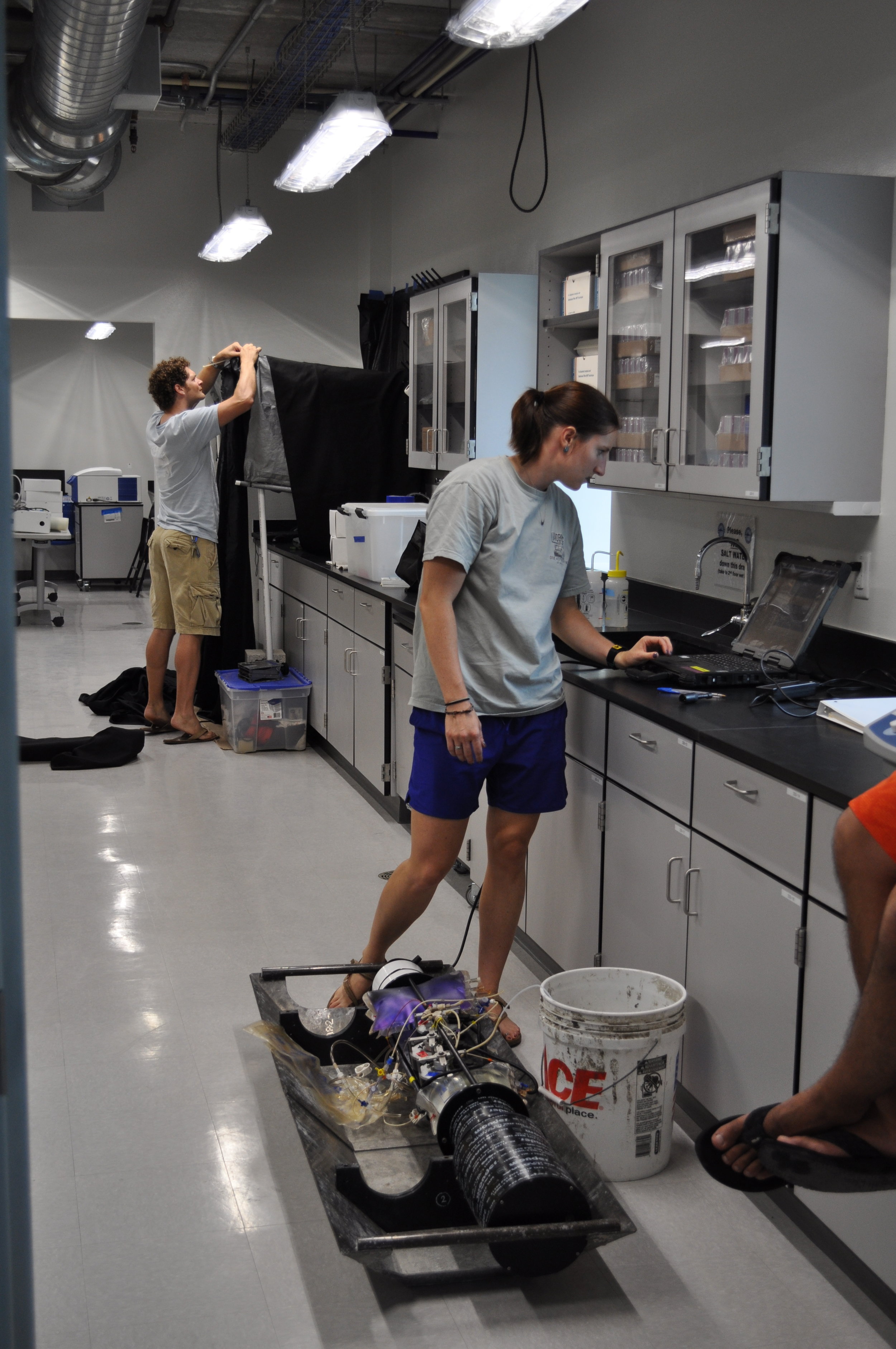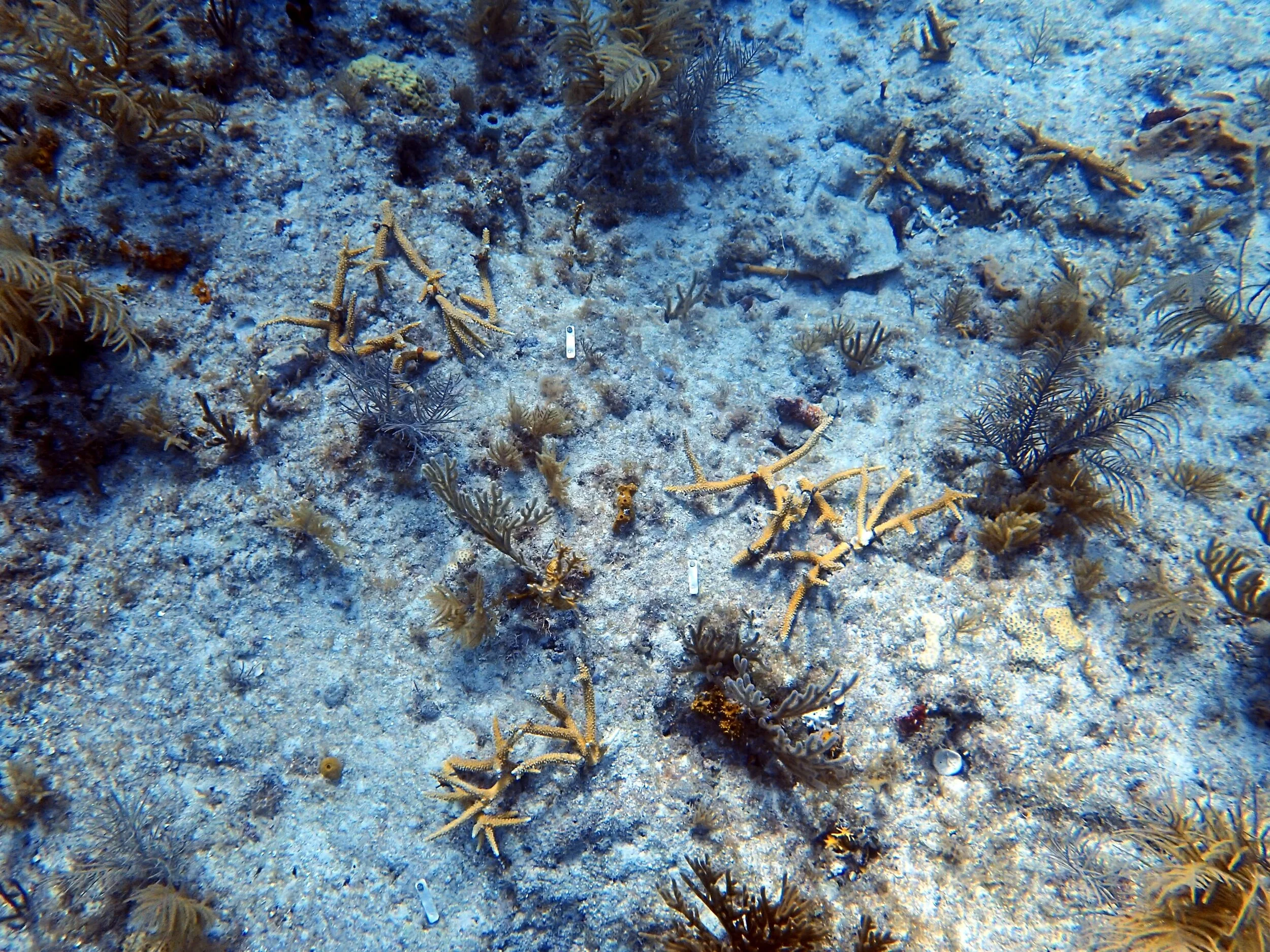Reef Restoration Monitoring: Characterizing net community metabolism changes among restored coral communities in the Florida Keys
2018-2021
mplatz@usf.edu
2018 Nursery Study
Photo Credit: Erich Bartels, Mote Marine Laboratory
Coral nurseries are a valuable ecological engineering tool to assist with coral reef ecological restoration efforts. While nursery methods are applied worldwide because of their success enhancing coral growth over short periods of time, little numerical and chemical data characterizing coral metabolism within offshore nurseries are available. This study aims to fill such a data gap by using previously-developed chemical monitoring technology to investigate coral metabolism, an intrinsic indicator of coral growth and functionality. This study represents the first steps in developing a method to remotely monitor coral nurseries, as well as transplanted coral on reef sites.
Technology
BEAMS
BEAMS deployed in Mote’s offshore coral nursery
The Benthic Ecosystem Acidification Monitoring System (BEAMS) was developed by Dr. Yuichiro Takeshita of the Monterrey Bay Aquarium Research Institute. BEAMS is composed of a set of sensors which measure pH and dissolved oxygen, as well as current velocity and photosynthetically active light radiation. Using the gradient flux approach, measurements made with the BEAMS technology can be used to assess the net community production and net community calcification of a sample site.
SEAS-DIC
The Spectrophotometric Elemental Analysis System - Dissolved Inorganic Carbon (SEAS-DIC) instrument is an in-situ, autonomous sensor developed by Dr. Xuewu Liu at the University of South Florida College of Marine Science in 2013, in the CO2 Chemistry Lab headed by Dr. Robert Byrne. The SEAS-DIC sensor provides high frequency measurements of dissolved inorganic carbon using an in-situ spectrophotometer. In this study, data collected with the SEAS-DIC will be used to estimate the photosynthetic quotient of the sample site, as well as make estimations of total alkalinity using pH, DIC, and site parameters such as salinity and temperature.
SEAS-DIC sensor prior to deployment
Check out photos from the August 2018 sensor installation at the Mote Marine Laboratory's offshore coral nursery! (Photo credit: Elizabeth Yancey)















































2019 Nursery Study
USF’s Reef Restoration Monitoring Project returned to the Mote Marine Laboratory’s IC2R3 Facility in March 2019 to perform a follow-up study in the offshore coral nursery. in August 2018, we used the BEAMS system to capture the net ecosystem metabolism of an array of coral fragments, newly mounted to Mote’s nursery modules. The coral cover of this array was similar to that of a reef site in need of restoration. In March of 2019, we wanted to see if BEAMS could be used to assess a reef restoration event, and performed a mock restoration in the offshore nursery using larger fragments harvested from Mote’s coral trees. We arranged these fragments in an array of similar fragment size and coral density to those which would be used on an actual reef restoration site, and placed the BEAMS system in the center of this array to monitor its community metabolism.
Check out photos from the March 2019 monitoring in the Mote Marine Laboratory's offshore coral nursery!











Check out the nursery study publication, Evaluating the potential for autonomous measurements of net community production and calcification as a tool for monitoring coral restoration, in the Journal Ecological Engineering here: https://doi.org/10.1016/j.ecoleng.2020.106042
2020 Reef Restoration Study
We’ve graduated from the nursery to the reef! Throughout the summer and fall of 2020, the project will be monitoring two reefs in the lower Florida Keys as they undergo coral restoration. In June and July 2020, two monitoring platforms were installed on Cudjoe Ledge and Marker 32 Reefs. These reefs will be monitored for several weeks to establish a baseline before being restored with coral fragments grown in Mote’s offshore coral nurseries. We will then continue monitoring after restoration to track how each reef’s community metabolism changes in response to reef restoration!
Check out this video from the June and July sensor installations:
In August, the Mote Marine Laboratory’s Coral Reef Monitoring & Assessment Program completed the coral restoration around the sensors, placing 75 Acropora cervicornis coral fragments in 15 clusters around the sensors at both reef monitoring sites. The sensors will continue to monitor the reef’s changing community metabolism as these fragments continue to grow over the next year and form new coral thickets.









Check out the video below to see one of our September fieldwork days, monitoring fragments one-month after transplantation, servicing sensors, downloading data, and replacing corals which had been lost to TS Laura.
2020 Ethnographic Study
In addition to reef restoration monitoring, in 2020 we will also be performing an ethnographic study of restoration practitioners and reef managers throughout the Florida Keys in collaboration with Strong Coast cohort member Kris-An Hinds from USF’s Department of Applied Anthropology! Throughout the summer, Kris-An and I have been interviewing different restoration practitioners, reef managers, and coral scientists to learn about the Florida Key’s community, discuss the extent of reef monitoring already taking place, what tools are still needed, and what factors might be inhibiting practitioners’ abilities to perform long-term restoration monitoring. Our study’s objective is to strengthen the relationship between ocean-based and land-based reef restoration in Florida by filling two predominant socio-environmental research gaps: 1.) literature detailing how reef decline and restoration has affected Florida Keys stakeholders, including residents, business owners, scientists, natural resource managers, and tourists; and 2.) published monitoring data evaluating the efficacy of Florida’s reef restoration efforts. By incorporating both social science and engineering perspectives, this project aims to identify leverage points within the reef restoration system to improve restoration monitoring and strengthen the relationships between the system’s stakeholders. More to come as Kris-An and I continue to learn about Florida’s treasured Reef Tract and the community of scientists and citizens diligently working to save it!
ACKNOWLEDGEMENTS
Special thanks to all our collaborators who made this study possible, especially the Takeshita Lab (MBARI) for providing the sensors and tech support to complete this study, and to the Mote Marine Laboratory's Coral Reef Monitoring & Assessment Program for their field support and for rearing and outplanting the corals used.
This work was supported, in part, by the University of South Florida Research & Innovation Internal Awards Program under Grant No. 0122985 and the David and Lucile Packard Foundation. This material is based upon work supported by the National Science Foundation Graduate Research Fellowship Program under Grant No. 2017247125. Any opinions, findings, and conclusions or recommendations expressed in this material are those of the author and do not necessarily reflect the views of the National Science Foundation.
This project is part of a continuing collaboration between the Watershed Sustainability Research Group, the Mote Marine Laboratory, the Monterey Bay Aquarium Research Institute, and USF’s NRT Strong Coasts! To learn more about USF’s Strong Coasts Program, please visit http://www.strongcoasts.org/



